Comparative Analysis: Risk Assessment in Domestic Violence Context
VerifiedAdded on 2023/06/04
|11
|3206
|435
Report
AI Summary
This report examines the critical role of risk assessment in the context of domestic violence, focusing on various tools and methodologies employed to identify and mitigate potential harm. It delves into three primary approaches: structured-clinical judgement, unstructured clinical decision-making, and paper-based tools, evaluating their respective advantages and limitations in predicting and preventing domestic violence. The report highlights structured-clinical judgement as an effective tool due to its reliability and accuracy in predicting future violence, while also acknowledging the flexibility of unstructured methods in adapting to individual victim circumstances. Paper-based tools, including surveys and questionnaires, are also explored for their role in gathering information and raising awareness. The study concludes with a recommendation for using structured-clinical judgement due to its generalizability and transparency, while also stressing the importance of considering the unique aspects of each case to ensure comprehensive victim safety.
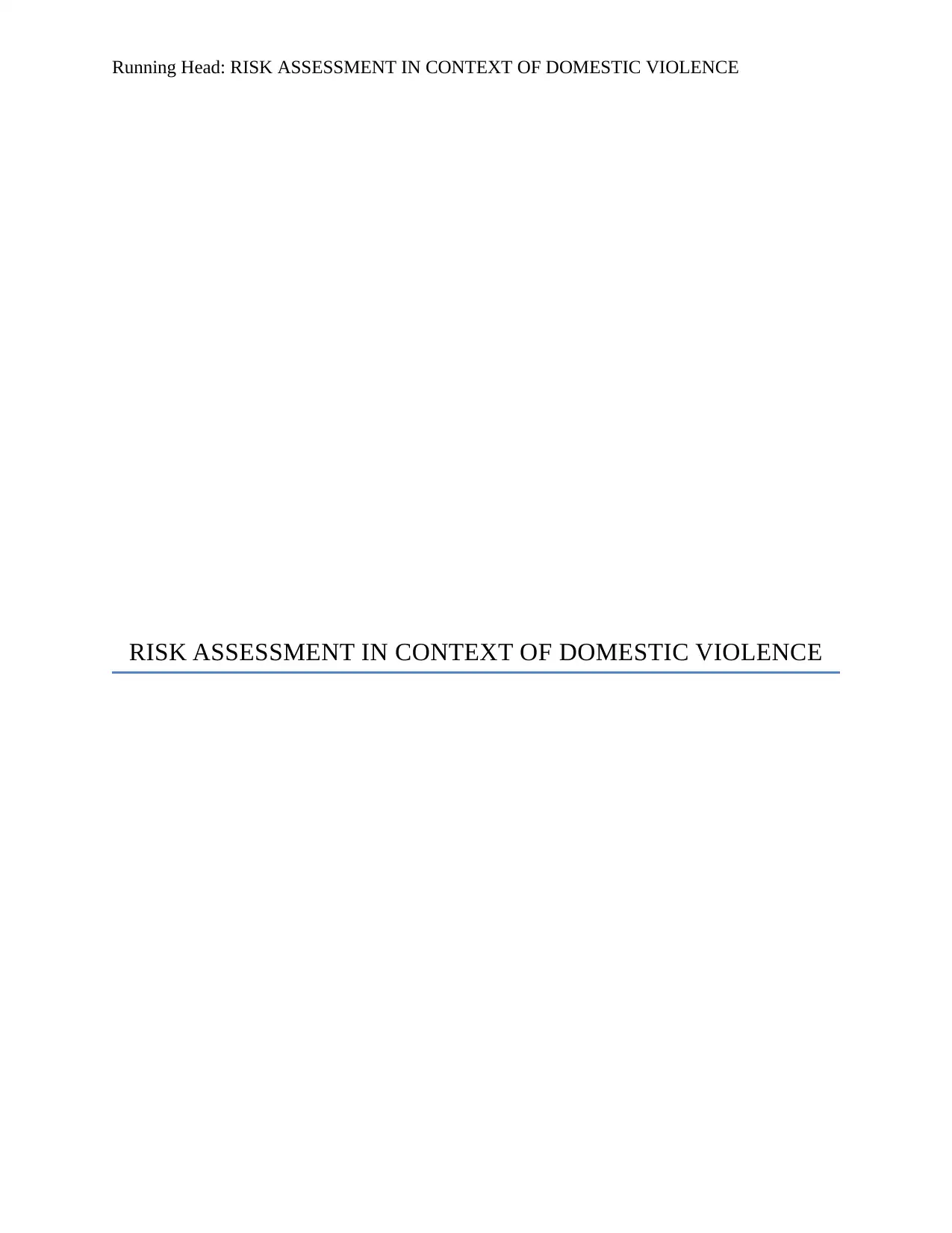
Running Head: RISK ASSESSMENT IN CONTEXT OF DOMESTIC VIOLENCE
RISK ASSESSMENT IN CONTEXT OF DOMESTIC VIOLENCE
RISK ASSESSMENT IN CONTEXT OF DOMESTIC VIOLENCE
Paraphrase This Document
Need a fresh take? Get an instant paraphrase of this document with our AI Paraphraser
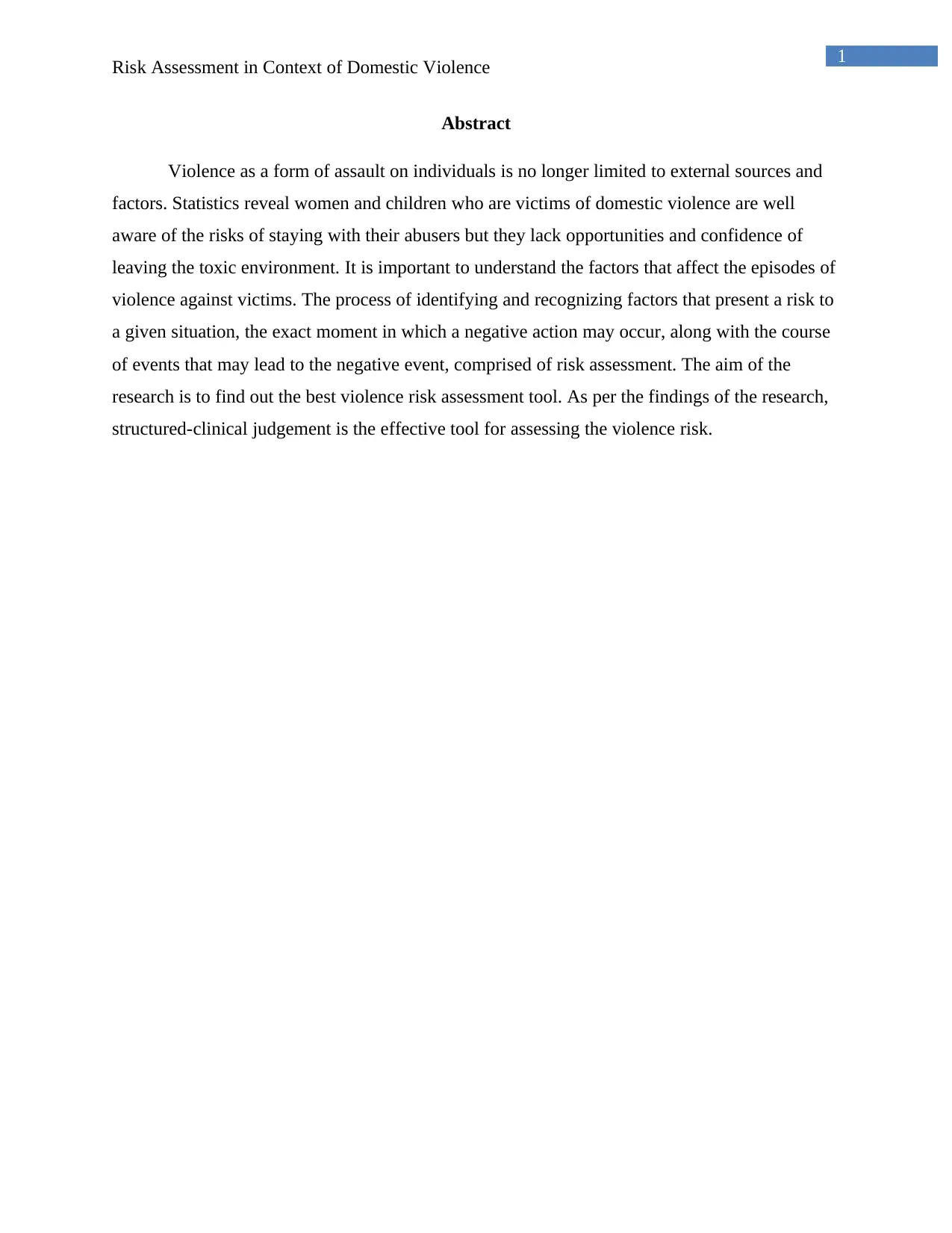
1
Risk Assessment in Context of Domestic Violence
Abstract
Violence as a form of assault on individuals is no longer limited to external sources and
factors. Statistics reveal women and children who are victims of domestic violence are well
aware of the risks of staying with their abusers but they lack opportunities and confidence of
leaving the toxic environment. It is important to understand the factors that affect the episodes of
violence against victims. The process of identifying and recognizing factors that present a risk to
a given situation, the exact moment in which a negative action may occur, along with the course
of events that may lead to the negative event, comprised of risk assessment. The aim of the
research is to find out the best violence risk assessment tool. As per the findings of the research,
structured-clinical judgement is the effective tool for assessing the violence risk.
Risk Assessment in Context of Domestic Violence
Abstract
Violence as a form of assault on individuals is no longer limited to external sources and
factors. Statistics reveal women and children who are victims of domestic violence are well
aware of the risks of staying with their abusers but they lack opportunities and confidence of
leaving the toxic environment. It is important to understand the factors that affect the episodes of
violence against victims. The process of identifying and recognizing factors that present a risk to
a given situation, the exact moment in which a negative action may occur, along with the course
of events that may lead to the negative event, comprised of risk assessment. The aim of the
research is to find out the best violence risk assessment tool. As per the findings of the research,
structured-clinical judgement is the effective tool for assessing the violence risk.
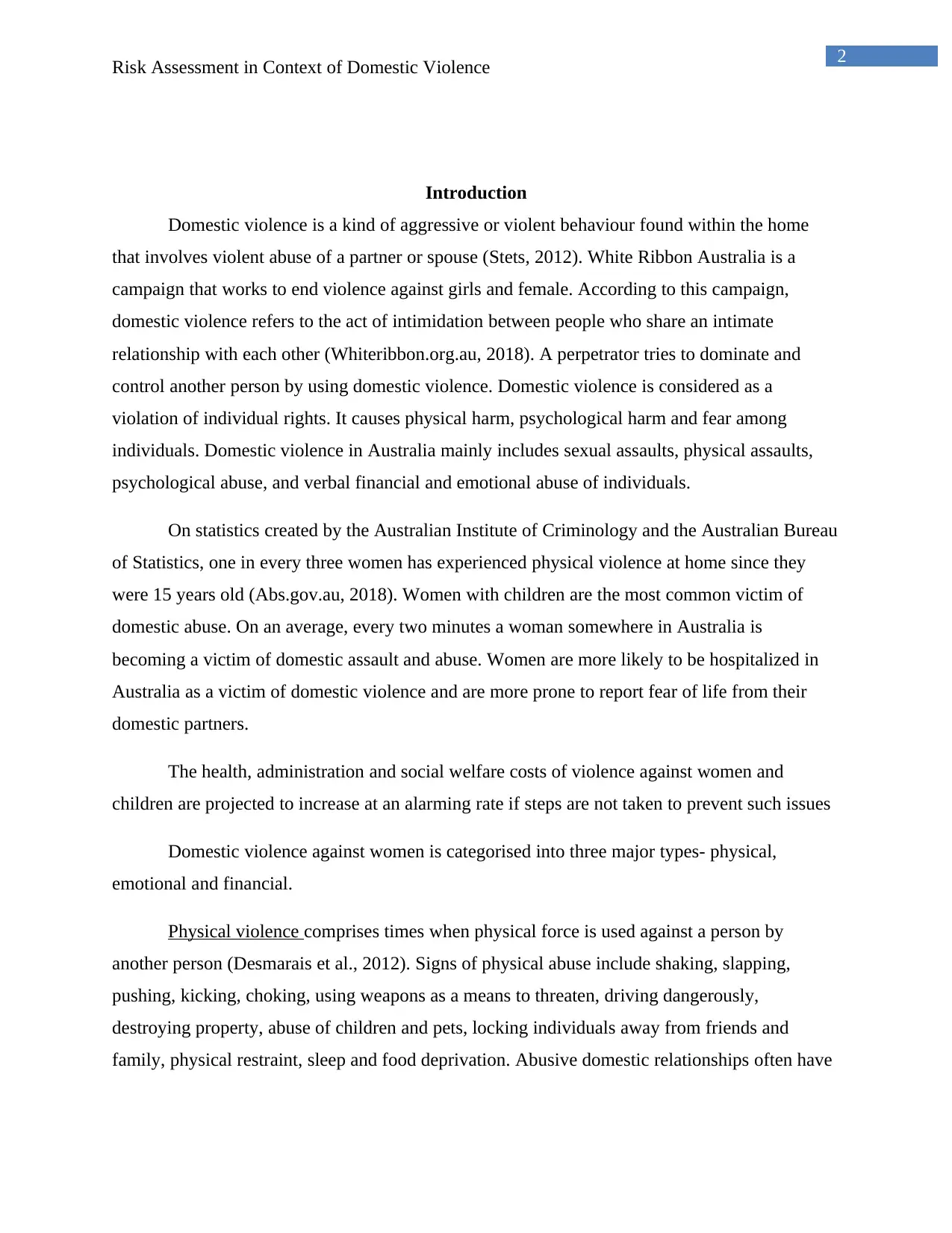
2
Risk Assessment in Context of Domestic Violence
Introduction
Domestic violence is a kind of aggressive or violent behaviour found within the home
that involves violent abuse of a partner or spouse (Stets, 2012). White Ribbon Australia is a
campaign that works to end violence against girls and female. According to this campaign,
domestic violence refers to the act of intimidation between people who share an intimate
relationship with each other (Whiteribbon.org.au, 2018). A perpetrator tries to dominate and
control another person by using domestic violence. Domestic violence is considered as a
violation of individual rights. It causes physical harm, psychological harm and fear among
individuals. Domestic violence in Australia mainly includes sexual assaults, physical assaults,
psychological abuse, and verbal financial and emotional abuse of individuals.
On statistics created by the Australian Institute of Criminology and the Australian Bureau
of Statistics, one in every three women has experienced physical violence at home since they
were 15 years old (Abs.gov.au, 2018). Women with children are the most common victim of
domestic abuse. On an average, every two minutes a woman somewhere in Australia is
becoming a victim of domestic assault and abuse. Women are more likely to be hospitalized in
Australia as a victim of domestic violence and are more prone to report fear of life from their
domestic partners.
The health, administration and social welfare costs of violence against women and
children are projected to increase at an alarming rate if steps are not taken to prevent such issues
Domestic violence against women is categorised into three major types- physical,
emotional and financial.
Physical violence comprises times when physical force is used against a person by
another person (Desmarais et al., 2012). Signs of physical abuse include shaking, slapping,
pushing, kicking, choking, using weapons as a means to threaten, driving dangerously,
destroying property, abuse of children and pets, locking individuals away from friends and
family, physical restraint, sleep and food deprivation. Abusive domestic relationships often have
Risk Assessment in Context of Domestic Violence
Introduction
Domestic violence is a kind of aggressive or violent behaviour found within the home
that involves violent abuse of a partner or spouse (Stets, 2012). White Ribbon Australia is a
campaign that works to end violence against girls and female. According to this campaign,
domestic violence refers to the act of intimidation between people who share an intimate
relationship with each other (Whiteribbon.org.au, 2018). A perpetrator tries to dominate and
control another person by using domestic violence. Domestic violence is considered as a
violation of individual rights. It causes physical harm, psychological harm and fear among
individuals. Domestic violence in Australia mainly includes sexual assaults, physical assaults,
psychological abuse, and verbal financial and emotional abuse of individuals.
On statistics created by the Australian Institute of Criminology and the Australian Bureau
of Statistics, one in every three women has experienced physical violence at home since they
were 15 years old (Abs.gov.au, 2018). Women with children are the most common victim of
domestic abuse. On an average, every two minutes a woman somewhere in Australia is
becoming a victim of domestic assault and abuse. Women are more likely to be hospitalized in
Australia as a victim of domestic violence and are more prone to report fear of life from their
domestic partners.
The health, administration and social welfare costs of violence against women and
children are projected to increase at an alarming rate if steps are not taken to prevent such issues
Domestic violence against women is categorised into three major types- physical,
emotional and financial.
Physical violence comprises times when physical force is used against a person by
another person (Desmarais et al., 2012). Signs of physical abuse include shaking, slapping,
pushing, kicking, choking, using weapons as a means to threaten, driving dangerously,
destroying property, abuse of children and pets, locking individuals away from friends and
family, physical restraint, sleep and food deprivation. Abusive domestic relationships often have
⊘ This is a preview!⊘
Do you want full access?
Subscribe today to unlock all pages.

Trusted by 1+ million students worldwide
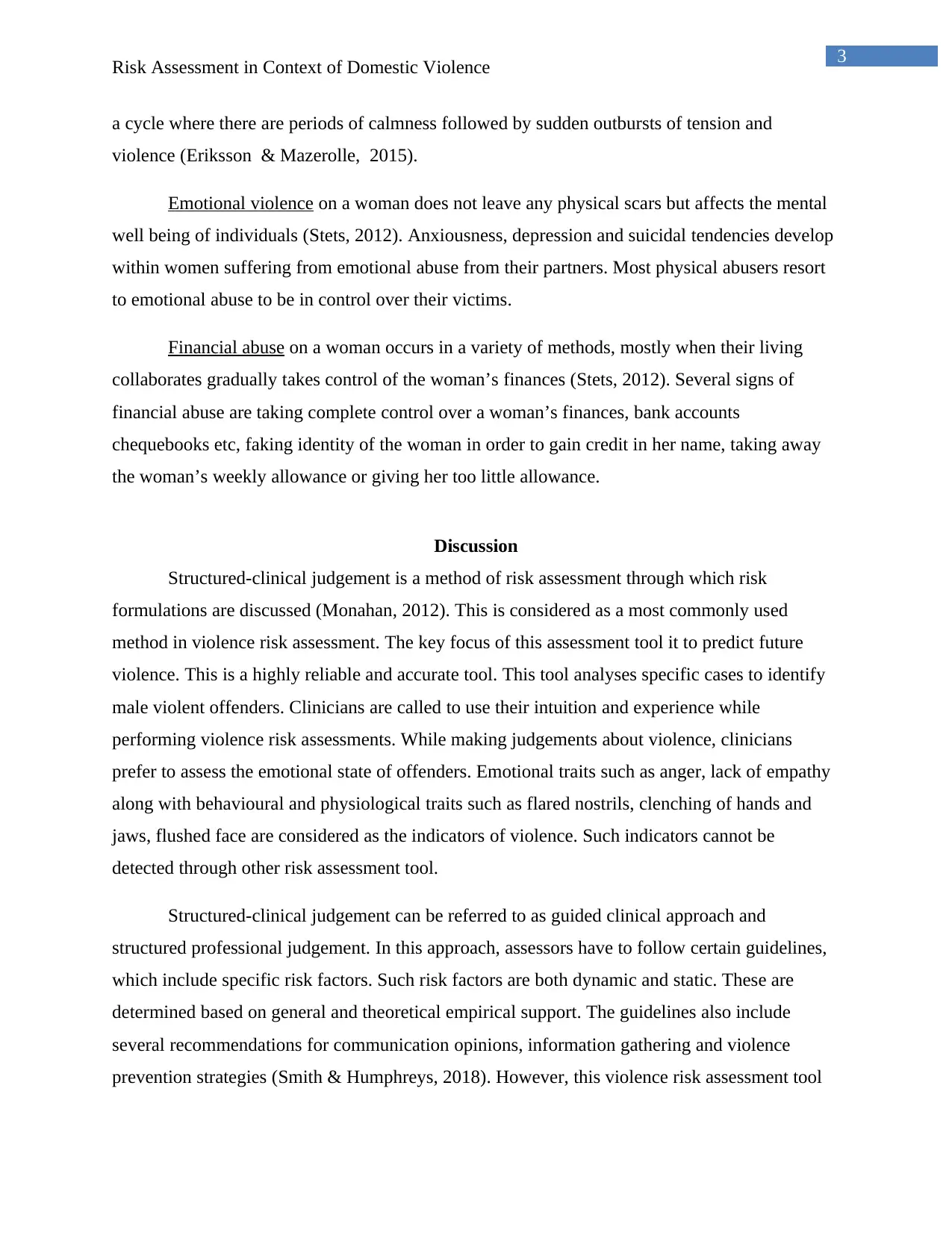
3
Risk Assessment in Context of Domestic Violence
a cycle where there are periods of calmness followed by sudden outbursts of tension and
violence (Eriksson & Mazerolle, 2015).
Emotional violence on a woman does not leave any physical scars but affects the mental
well being of individuals (Stets, 2012). Anxiousness, depression and suicidal tendencies develop
within women suffering from emotional abuse from their partners. Most physical abusers resort
to emotional abuse to be in control over their victims.
Financial abuse on a woman occurs in a variety of methods, mostly when their living
collaborates gradually takes control of the woman’s finances (Stets, 2012). Several signs of
financial abuse are taking complete control over a woman’s finances, bank accounts
chequebooks etc, faking identity of the woman in order to gain credit in her name, taking away
the woman’s weekly allowance or giving her too little allowance.
Discussion
Structured-clinical judgement is a method of risk assessment through which risk
formulations are discussed (Monahan, 2012). This is considered as a most commonly used
method in violence risk assessment. The key focus of this assessment tool it to predict future
violence. This is a highly reliable and accurate tool. This tool analyses specific cases to identify
male violent offenders. Clinicians are called to use their intuition and experience while
performing violence risk assessments. While making judgements about violence, clinicians
prefer to assess the emotional state of offenders. Emotional traits such as anger, lack of empathy
along with behavioural and physiological traits such as flared nostrils, clenching of hands and
jaws, flushed face are considered as the indicators of violence. Such indicators cannot be
detected through other risk assessment tool.
Structured-clinical judgement can be referred to as guided clinical approach and
structured professional judgement. In this approach, assessors have to follow certain guidelines,
which include specific risk factors. Such risk factors are both dynamic and static. These are
determined based on general and theoretical empirical support. The guidelines also include
several recommendations for communication opinions, information gathering and violence
prevention strategies (Smith & Humphreys, 2018). However, this violence risk assessment tool
Risk Assessment in Context of Domestic Violence
a cycle where there are periods of calmness followed by sudden outbursts of tension and
violence (Eriksson & Mazerolle, 2015).
Emotional violence on a woman does not leave any physical scars but affects the mental
well being of individuals (Stets, 2012). Anxiousness, depression and suicidal tendencies develop
within women suffering from emotional abuse from their partners. Most physical abusers resort
to emotional abuse to be in control over their victims.
Financial abuse on a woman occurs in a variety of methods, mostly when their living
collaborates gradually takes control of the woman’s finances (Stets, 2012). Several signs of
financial abuse are taking complete control over a woman’s finances, bank accounts
chequebooks etc, faking identity of the woman in order to gain credit in her name, taking away
the woman’s weekly allowance or giving her too little allowance.
Discussion
Structured-clinical judgement is a method of risk assessment through which risk
formulations are discussed (Monahan, 2012). This is considered as a most commonly used
method in violence risk assessment. The key focus of this assessment tool it to predict future
violence. This is a highly reliable and accurate tool. This tool analyses specific cases to identify
male violent offenders. Clinicians are called to use their intuition and experience while
performing violence risk assessments. While making judgements about violence, clinicians
prefer to assess the emotional state of offenders. Emotional traits such as anger, lack of empathy
along with behavioural and physiological traits such as flared nostrils, clenching of hands and
jaws, flushed face are considered as the indicators of violence. Such indicators cannot be
detected through other risk assessment tool.
Structured-clinical judgement can be referred to as guided clinical approach and
structured professional judgement. In this approach, assessors have to follow certain guidelines,
which include specific risk factors. Such risk factors are both dynamic and static. These are
determined based on general and theoretical empirical support. The guidelines also include
several recommendations for communication opinions, information gathering and violence
prevention strategies (Smith & Humphreys, 2018). However, this violence risk assessment tool
Paraphrase This Document
Need a fresh take? Get an instant paraphrase of this document with our AI Paraphraser
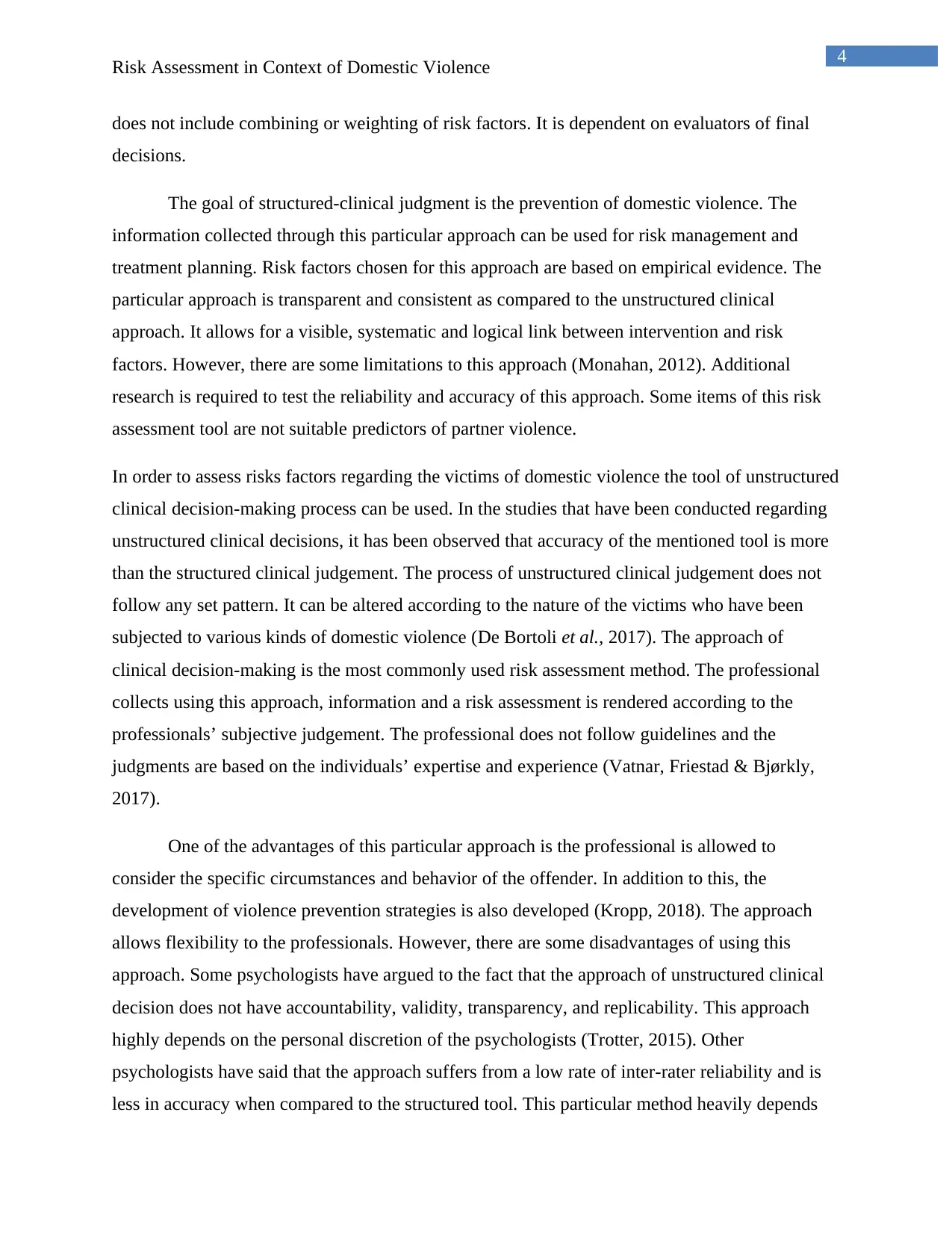
4
Risk Assessment in Context of Domestic Violence
does not include combining or weighting of risk factors. It is dependent on evaluators of final
decisions.
The goal of structured-clinical judgment is the prevention of domestic violence. The
information collected through this particular approach can be used for risk management and
treatment planning. Risk factors chosen for this approach are based on empirical evidence. The
particular approach is transparent and consistent as compared to the unstructured clinical
approach. It allows for a visible, systematic and logical link between intervention and risk
factors. However, there are some limitations to this approach (Monahan, 2012). Additional
research is required to test the reliability and accuracy of this approach. Some items of this risk
assessment tool are not suitable predictors of partner violence.
In order to assess risks factors regarding the victims of domestic violence the tool of unstructured
clinical decision-making process can be used. In the studies that have been conducted regarding
unstructured clinical decisions, it has been observed that accuracy of the mentioned tool is more
than the structured clinical judgement. The process of unstructured clinical judgement does not
follow any set pattern. It can be altered according to the nature of the victims who have been
subjected to various kinds of domestic violence (De Bortoli et al., 2017). The approach of
clinical decision-making is the most commonly used risk assessment method. The professional
collects using this approach, information and a risk assessment is rendered according to the
professionals’ subjective judgement. The professional does not follow guidelines and the
judgments are based on the individuals’ expertise and experience (Vatnar, Friestad & Bjørkly,
2017).
One of the advantages of this particular approach is the professional is allowed to
consider the specific circumstances and behavior of the offender. In addition to this, the
development of violence prevention strategies is also developed (Kropp, 2018). The approach
allows flexibility to the professionals. However, there are some disadvantages of using this
approach. Some psychologists have argued to the fact that the approach of unstructured clinical
decision does not have accountability, validity, transparency, and replicability. This approach
highly depends on the personal discretion of the psychologists (Trotter, 2015). Other
psychologists have said that the approach suffers from a low rate of inter-rater reliability and is
less in accuracy when compared to the structured tool. This particular method heavily depends
Risk Assessment in Context of Domestic Violence
does not include combining or weighting of risk factors. It is dependent on evaluators of final
decisions.
The goal of structured-clinical judgment is the prevention of domestic violence. The
information collected through this particular approach can be used for risk management and
treatment planning. Risk factors chosen for this approach are based on empirical evidence. The
particular approach is transparent and consistent as compared to the unstructured clinical
approach. It allows for a visible, systematic and logical link between intervention and risk
factors. However, there are some limitations to this approach (Monahan, 2012). Additional
research is required to test the reliability and accuracy of this approach. Some items of this risk
assessment tool are not suitable predictors of partner violence.
In order to assess risks factors regarding the victims of domestic violence the tool of unstructured
clinical decision-making process can be used. In the studies that have been conducted regarding
unstructured clinical decisions, it has been observed that accuracy of the mentioned tool is more
than the structured clinical judgement. The process of unstructured clinical judgement does not
follow any set pattern. It can be altered according to the nature of the victims who have been
subjected to various kinds of domestic violence (De Bortoli et al., 2017). The approach of
clinical decision-making is the most commonly used risk assessment method. The professional
collects using this approach, information and a risk assessment is rendered according to the
professionals’ subjective judgement. The professional does not follow guidelines and the
judgments are based on the individuals’ expertise and experience (Vatnar, Friestad & Bjørkly,
2017).
One of the advantages of this particular approach is the professional is allowed to
consider the specific circumstances and behavior of the offender. In addition to this, the
development of violence prevention strategies is also developed (Kropp, 2018). The approach
allows flexibility to the professionals. However, there are some disadvantages of using this
approach. Some psychologists have argued to the fact that the approach of unstructured clinical
decision does not have accountability, validity, transparency, and replicability. This approach
highly depends on the personal discretion of the psychologists (Trotter, 2015). Other
psychologists have said that the approach suffers from a low rate of inter-rater reliability and is
less in accuracy when compared to the structured tool. This particular method heavily depends
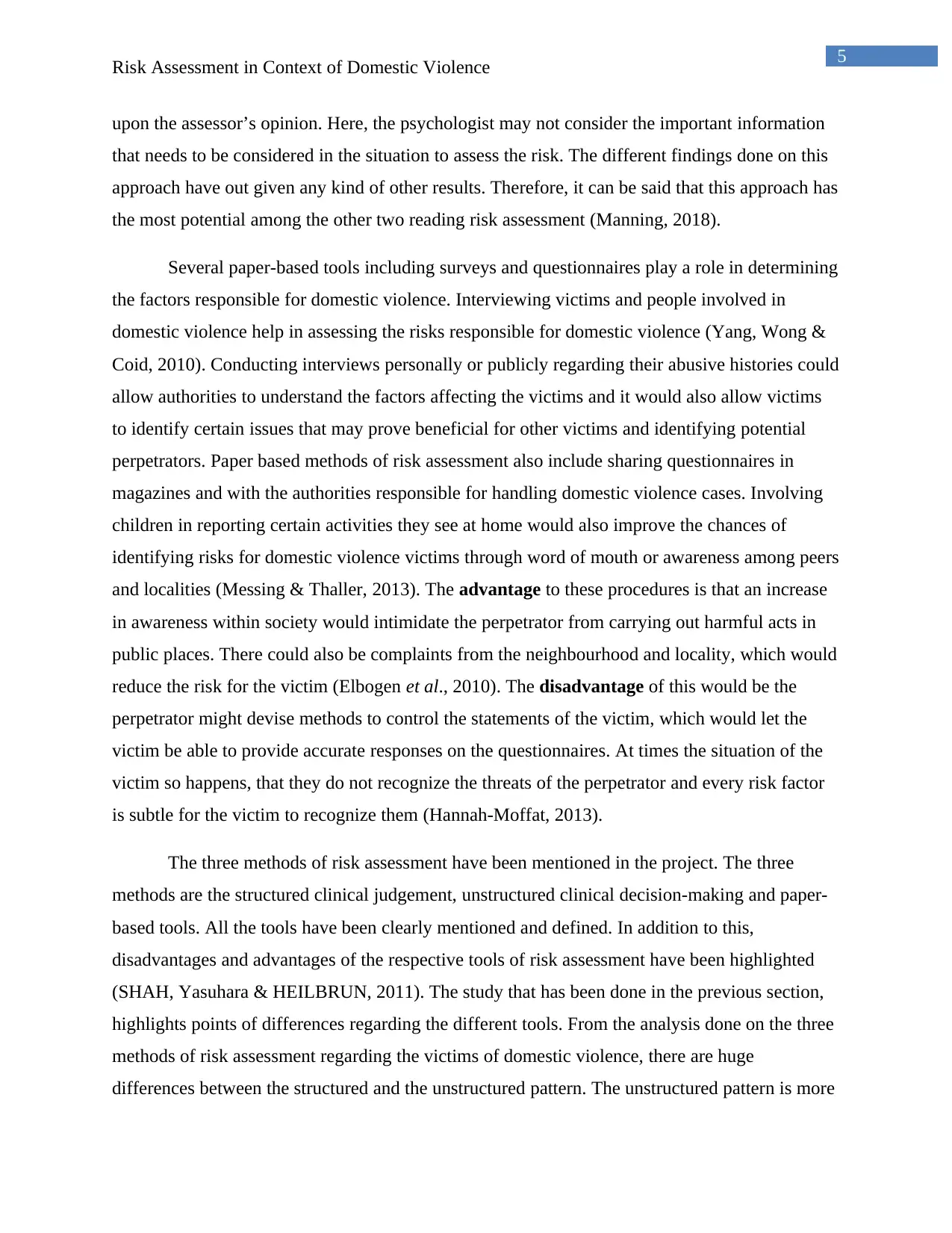
5
Risk Assessment in Context of Domestic Violence
upon the assessor’s opinion. Here, the psychologist may not consider the important information
that needs to be considered in the situation to assess the risk. The different findings done on this
approach have out given any kind of other results. Therefore, it can be said that this approach has
the most potential among the other two reading risk assessment (Manning, 2018).
Several paper-based tools including surveys and questionnaires play a role in determining
the factors responsible for domestic violence. Interviewing victims and people involved in
domestic violence help in assessing the risks responsible for domestic violence (Yang, Wong &
Coid, 2010). Conducting interviews personally or publicly regarding their abusive histories could
allow authorities to understand the factors affecting the victims and it would also allow victims
to identify certain issues that may prove beneficial for other victims and identifying potential
perpetrators. Paper based methods of risk assessment also include sharing questionnaires in
magazines and with the authorities responsible for handling domestic violence cases. Involving
children in reporting certain activities they see at home would also improve the chances of
identifying risks for domestic violence victims through word of mouth or awareness among peers
and localities (Messing & Thaller, 2013). The advantage to these procedures is that an increase
in awareness within society would intimidate the perpetrator from carrying out harmful acts in
public places. There could also be complaints from the neighbourhood and locality, which would
reduce the risk for the victim (Elbogen et al., 2010). The disadvantage of this would be the
perpetrator might devise methods to control the statements of the victim, which would let the
victim be able to provide accurate responses on the questionnaires. At times the situation of the
victim so happens, that they do not recognize the threats of the perpetrator and every risk factor
is subtle for the victim to recognize them (Hannah-Moffat, 2013).
The three methods of risk assessment have been mentioned in the project. The three
methods are the structured clinical judgement, unstructured clinical decision-making and paper-
based tools. All the tools have been clearly mentioned and defined. In addition to this,
disadvantages and advantages of the respective tools of risk assessment have been highlighted
(SHAH, Yasuhara & HEILBRUN, 2011). The study that has been done in the previous section,
highlights points of differences regarding the different tools. From the analysis done on the three
methods of risk assessment regarding the victims of domestic violence, there are huge
differences between the structured and the unstructured pattern. The unstructured pattern is more
Risk Assessment in Context of Domestic Violence
upon the assessor’s opinion. Here, the psychologist may not consider the important information
that needs to be considered in the situation to assess the risk. The different findings done on this
approach have out given any kind of other results. Therefore, it can be said that this approach has
the most potential among the other two reading risk assessment (Manning, 2018).
Several paper-based tools including surveys and questionnaires play a role in determining
the factors responsible for domestic violence. Interviewing victims and people involved in
domestic violence help in assessing the risks responsible for domestic violence (Yang, Wong &
Coid, 2010). Conducting interviews personally or publicly regarding their abusive histories could
allow authorities to understand the factors affecting the victims and it would also allow victims
to identify certain issues that may prove beneficial for other victims and identifying potential
perpetrators. Paper based methods of risk assessment also include sharing questionnaires in
magazines and with the authorities responsible for handling domestic violence cases. Involving
children in reporting certain activities they see at home would also improve the chances of
identifying risks for domestic violence victims through word of mouth or awareness among peers
and localities (Messing & Thaller, 2013). The advantage to these procedures is that an increase
in awareness within society would intimidate the perpetrator from carrying out harmful acts in
public places. There could also be complaints from the neighbourhood and locality, which would
reduce the risk for the victim (Elbogen et al., 2010). The disadvantage of this would be the
perpetrator might devise methods to control the statements of the victim, which would let the
victim be able to provide accurate responses on the questionnaires. At times the situation of the
victim so happens, that they do not recognize the threats of the perpetrator and every risk factor
is subtle for the victim to recognize them (Hannah-Moffat, 2013).
The three methods of risk assessment have been mentioned in the project. The three
methods are the structured clinical judgement, unstructured clinical decision-making and paper-
based tools. All the tools have been clearly mentioned and defined. In addition to this,
disadvantages and advantages of the respective tools of risk assessment have been highlighted
(SHAH, Yasuhara & HEILBRUN, 2011). The study that has been done in the previous section,
highlights points of differences regarding the different tools. From the analysis done on the three
methods of risk assessment regarding the victims of domestic violence, there are huge
differences between the structured and the unstructured pattern. The unstructured pattern is more
⊘ This is a preview!⊘
Do you want full access?
Subscribe today to unlock all pages.

Trusted by 1+ million students worldwide
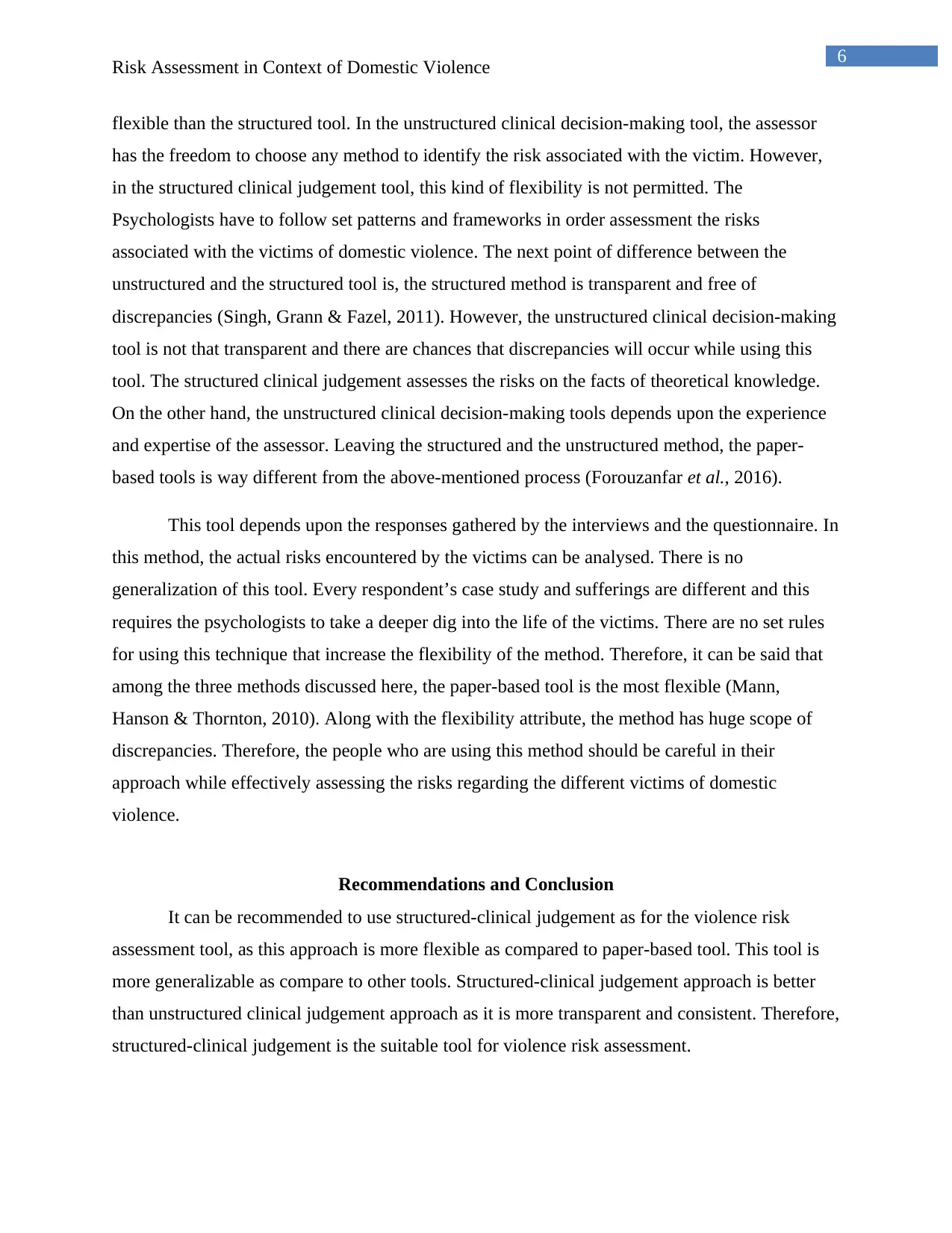
6
Risk Assessment in Context of Domestic Violence
flexible than the structured tool. In the unstructured clinical decision-making tool, the assessor
has the freedom to choose any method to identify the risk associated with the victim. However,
in the structured clinical judgement tool, this kind of flexibility is not permitted. The
Psychologists have to follow set patterns and frameworks in order assessment the risks
associated with the victims of domestic violence. The next point of difference between the
unstructured and the structured tool is, the structured method is transparent and free of
discrepancies (Singh, Grann & Fazel, 2011). However, the unstructured clinical decision-making
tool is not that transparent and there are chances that discrepancies will occur while using this
tool. The structured clinical judgement assesses the risks on the facts of theoretical knowledge.
On the other hand, the unstructured clinical decision-making tools depends upon the experience
and expertise of the assessor. Leaving the structured and the unstructured method, the paper-
based tools is way different from the above-mentioned process (Forouzanfar et al., 2016).
This tool depends upon the responses gathered by the interviews and the questionnaire. In
this method, the actual risks encountered by the victims can be analysed. There is no
generalization of this tool. Every respondent’s case study and sufferings are different and this
requires the psychologists to take a deeper dig into the life of the victims. There are no set rules
for using this technique that increase the flexibility of the method. Therefore, it can be said that
among the three methods discussed here, the paper-based tool is the most flexible (Mann,
Hanson & Thornton, 2010). Along with the flexibility attribute, the method has huge scope of
discrepancies. Therefore, the people who are using this method should be careful in their
approach while effectively assessing the risks regarding the different victims of domestic
violence.
Recommendations and Conclusion
It can be recommended to use structured-clinical judgement as for the violence risk
assessment tool, as this approach is more flexible as compared to paper-based tool. This tool is
more generalizable as compare to other tools. Structured-clinical judgement approach is better
than unstructured clinical judgement approach as it is more transparent and consistent. Therefore,
structured-clinical judgement is the suitable tool for violence risk assessment.
Risk Assessment in Context of Domestic Violence
flexible than the structured tool. In the unstructured clinical decision-making tool, the assessor
has the freedom to choose any method to identify the risk associated with the victim. However,
in the structured clinical judgement tool, this kind of flexibility is not permitted. The
Psychologists have to follow set patterns and frameworks in order assessment the risks
associated with the victims of domestic violence. The next point of difference between the
unstructured and the structured tool is, the structured method is transparent and free of
discrepancies (Singh, Grann & Fazel, 2011). However, the unstructured clinical decision-making
tool is not that transparent and there are chances that discrepancies will occur while using this
tool. The structured clinical judgement assesses the risks on the facts of theoretical knowledge.
On the other hand, the unstructured clinical decision-making tools depends upon the experience
and expertise of the assessor. Leaving the structured and the unstructured method, the paper-
based tools is way different from the above-mentioned process (Forouzanfar et al., 2016).
This tool depends upon the responses gathered by the interviews and the questionnaire. In
this method, the actual risks encountered by the victims can be analysed. There is no
generalization of this tool. Every respondent’s case study and sufferings are different and this
requires the psychologists to take a deeper dig into the life of the victims. There are no set rules
for using this technique that increase the flexibility of the method. Therefore, it can be said that
among the three methods discussed here, the paper-based tool is the most flexible (Mann,
Hanson & Thornton, 2010). Along with the flexibility attribute, the method has huge scope of
discrepancies. Therefore, the people who are using this method should be careful in their
approach while effectively assessing the risks regarding the different victims of domestic
violence.
Recommendations and Conclusion
It can be recommended to use structured-clinical judgement as for the violence risk
assessment tool, as this approach is more flexible as compared to paper-based tool. This tool is
more generalizable as compare to other tools. Structured-clinical judgement approach is better
than unstructured clinical judgement approach as it is more transparent and consistent. Therefore,
structured-clinical judgement is the suitable tool for violence risk assessment.
Paraphrase This Document
Need a fresh take? Get an instant paraphrase of this document with our AI Paraphraser
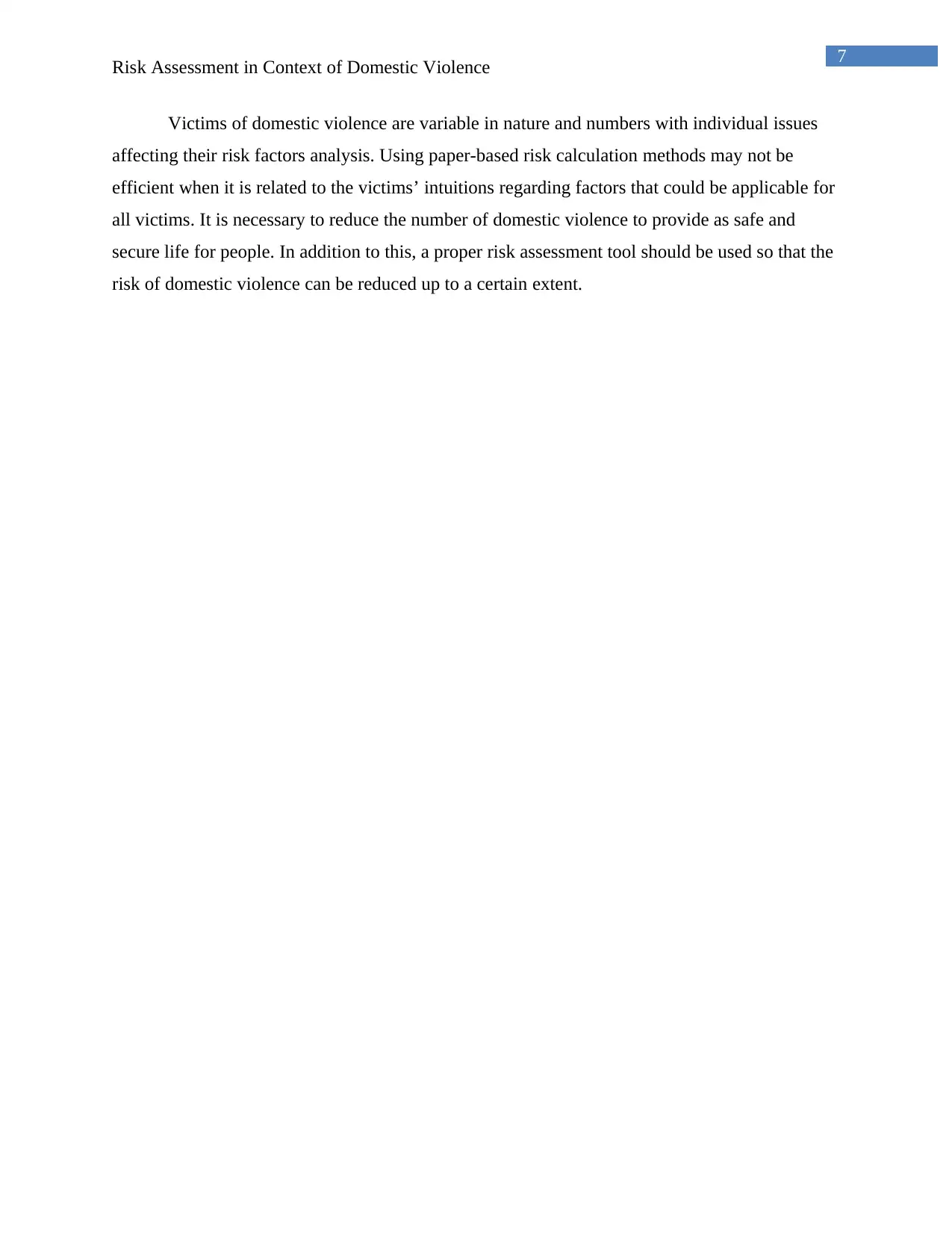
7
Risk Assessment in Context of Domestic Violence
Victims of domestic violence are variable in nature and numbers with individual issues
affecting their risk factors analysis. Using paper-based risk calculation methods may not be
efficient when it is related to the victims’ intuitions regarding factors that could be applicable for
all victims. It is necessary to reduce the number of domestic violence to provide as safe and
secure life for people. In addition to this, a proper risk assessment tool should be used so that the
risk of domestic violence can be reduced up to a certain extent.
Risk Assessment in Context of Domestic Violence
Victims of domestic violence are variable in nature and numbers with individual issues
affecting their risk factors analysis. Using paper-based risk calculation methods may not be
efficient when it is related to the victims’ intuitions regarding factors that could be applicable for
all victims. It is necessary to reduce the number of domestic violence to provide as safe and
secure life for people. In addition to this, a proper risk assessment tool should be used so that the
risk of domestic violence can be reduced up to a certain extent.
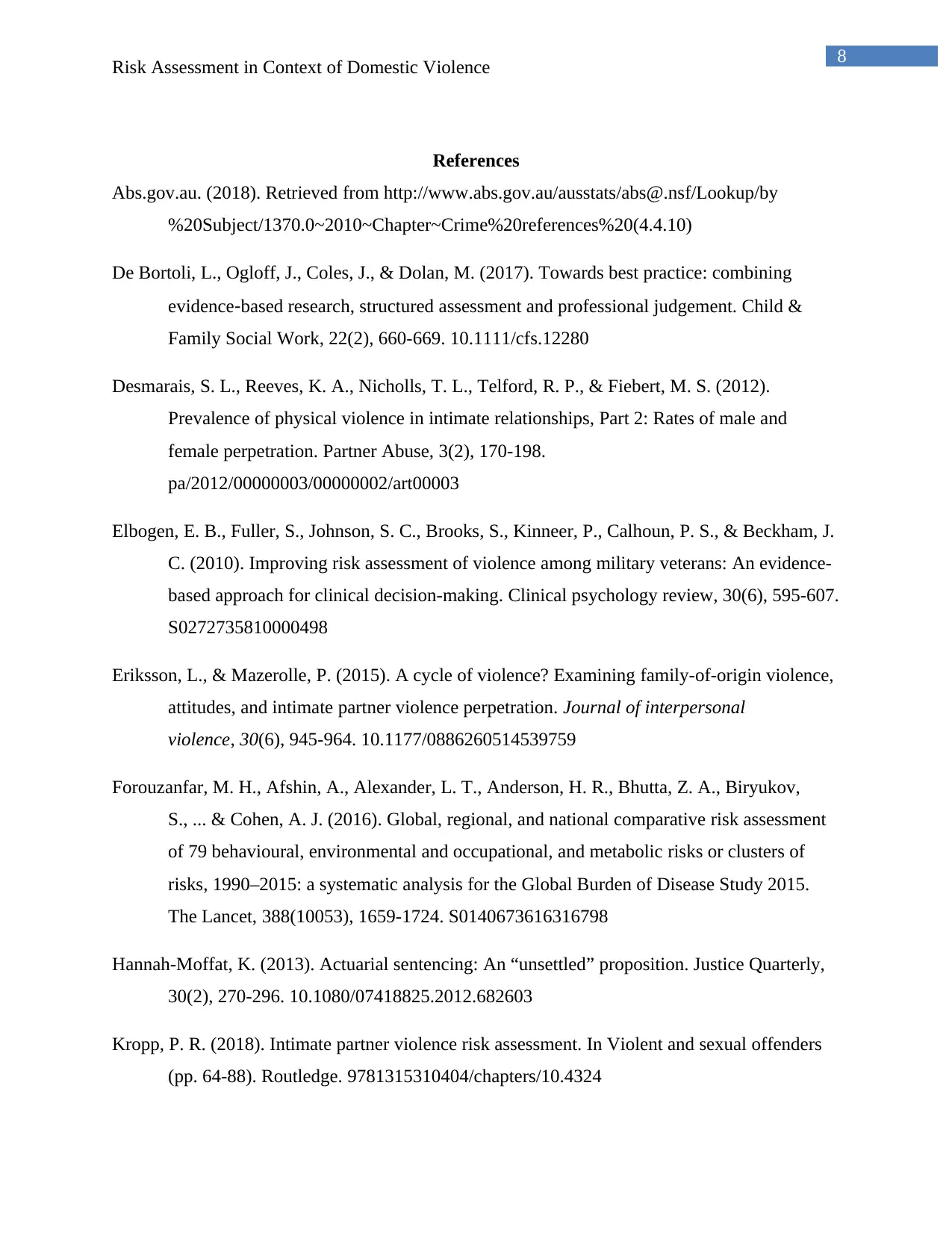
8
Risk Assessment in Context of Domestic Violence
References
Abs.gov.au. (2018). Retrieved from http://www.abs.gov.au/ausstats/abs@.nsf/Lookup/by
%20Subject/1370.0~2010~Chapter~Crime%20references%20(4.4.10)
De Bortoli, L., Ogloff, J., Coles, J., & Dolan, M. (2017). Towards best practice: combining
evidence‐based research, structured assessment and professional judgement. Child &
Family Social Work, 22(2), 660-669. 10.1111/cfs.12280
Desmarais, S. L., Reeves, K. A., Nicholls, T. L., Telford, R. P., & Fiebert, M. S. (2012).
Prevalence of physical violence in intimate relationships, Part 2: Rates of male and
female perpetration. Partner Abuse, 3(2), 170-198.
pa/2012/00000003/00000002/art00003
Elbogen, E. B., Fuller, S., Johnson, S. C., Brooks, S., Kinneer, P., Calhoun, P. S., & Beckham, J.
C. (2010). Improving risk assessment of violence among military veterans: An evidence-
based approach for clinical decision-making. Clinical psychology review, 30(6), 595-607.
S0272735810000498
Eriksson, L., & Mazerolle, P. (2015). A cycle of violence? Examining family-of-origin violence,
attitudes, and intimate partner violence perpetration. Journal of interpersonal
violence, 30(6), 945-964. 10.1177/0886260514539759
Forouzanfar, M. H., Afshin, A., Alexander, L. T., Anderson, H. R., Bhutta, Z. A., Biryukov,
S., ... & Cohen, A. J. (2016). Global, regional, and national comparative risk assessment
of 79 behavioural, environmental and occupational, and metabolic risks or clusters of
risks, 1990–2015: a systematic analysis for the Global Burden of Disease Study 2015.
The Lancet, 388(10053), 1659-1724. S0140673616316798
Hannah-Moffat, K. (2013). Actuarial sentencing: An “unsettled” proposition. Justice Quarterly,
30(2), 270-296. 10.1080/07418825.2012.682603
Kropp, P. R. (2018). Intimate partner violence risk assessment. In Violent and sexual offenders
(pp. 64-88). Routledge. 9781315310404/chapters/10.4324
Risk Assessment in Context of Domestic Violence
References
Abs.gov.au. (2018). Retrieved from http://www.abs.gov.au/ausstats/abs@.nsf/Lookup/by
%20Subject/1370.0~2010~Chapter~Crime%20references%20(4.4.10)
De Bortoli, L., Ogloff, J., Coles, J., & Dolan, M. (2017). Towards best practice: combining
evidence‐based research, structured assessment and professional judgement. Child &
Family Social Work, 22(2), 660-669. 10.1111/cfs.12280
Desmarais, S. L., Reeves, K. A., Nicholls, T. L., Telford, R. P., & Fiebert, M. S. (2012).
Prevalence of physical violence in intimate relationships, Part 2: Rates of male and
female perpetration. Partner Abuse, 3(2), 170-198.
pa/2012/00000003/00000002/art00003
Elbogen, E. B., Fuller, S., Johnson, S. C., Brooks, S., Kinneer, P., Calhoun, P. S., & Beckham, J.
C. (2010). Improving risk assessment of violence among military veterans: An evidence-
based approach for clinical decision-making. Clinical psychology review, 30(6), 595-607.
S0272735810000498
Eriksson, L., & Mazerolle, P. (2015). A cycle of violence? Examining family-of-origin violence,
attitudes, and intimate partner violence perpetration. Journal of interpersonal
violence, 30(6), 945-964. 10.1177/0886260514539759
Forouzanfar, M. H., Afshin, A., Alexander, L. T., Anderson, H. R., Bhutta, Z. A., Biryukov,
S., ... & Cohen, A. J. (2016). Global, regional, and national comparative risk assessment
of 79 behavioural, environmental and occupational, and metabolic risks or clusters of
risks, 1990–2015: a systematic analysis for the Global Burden of Disease Study 2015.
The Lancet, 388(10053), 1659-1724. S0140673616316798
Hannah-Moffat, K. (2013). Actuarial sentencing: An “unsettled” proposition. Justice Quarterly,
30(2), 270-296. 10.1080/07418825.2012.682603
Kropp, P. R. (2018). Intimate partner violence risk assessment. In Violent and sexual offenders
(pp. 64-88). Routledge. 9781315310404/chapters/10.4324
⊘ This is a preview!⊘
Do you want full access?
Subscribe today to unlock all pages.

Trusted by 1+ million students worldwide
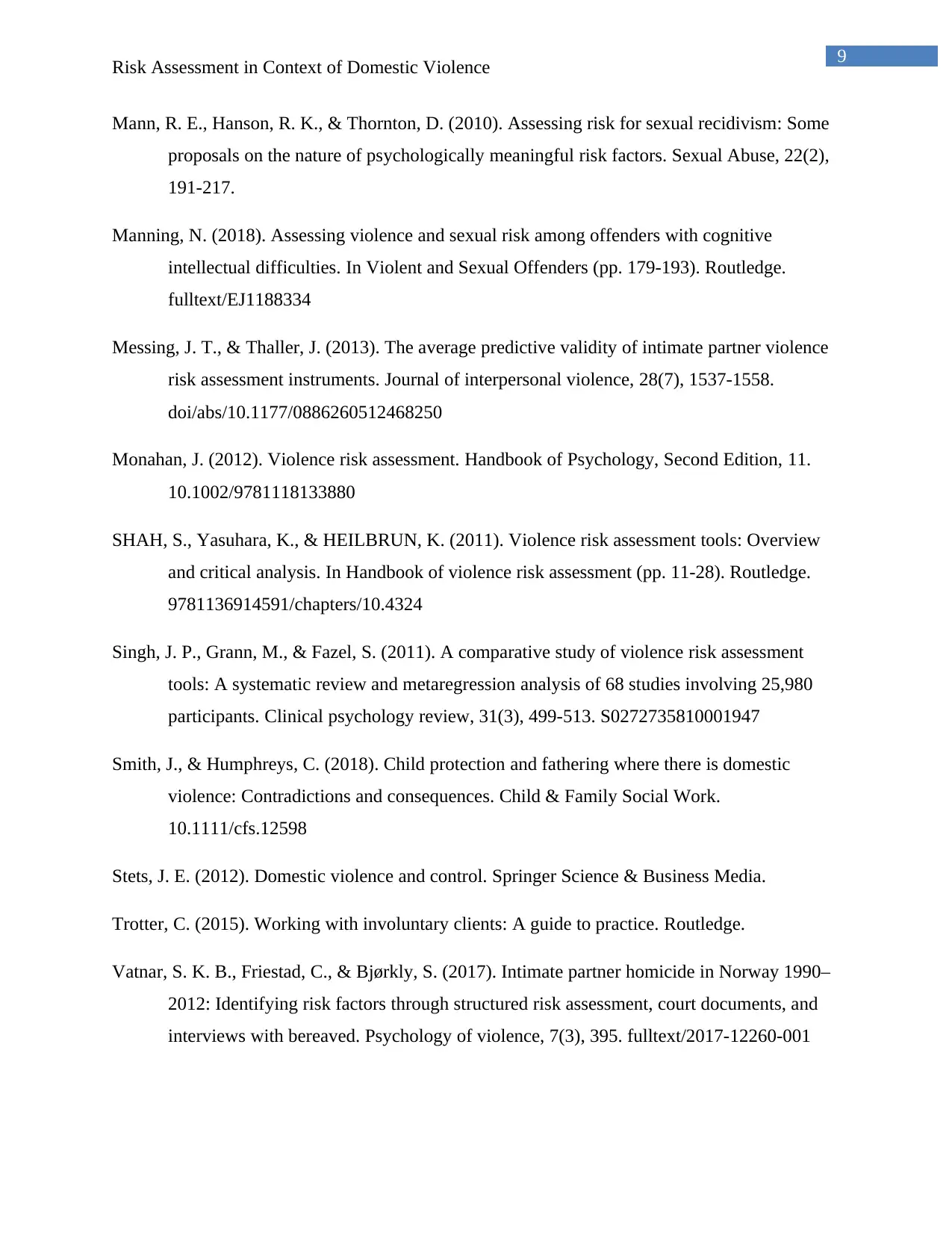
9
Risk Assessment in Context of Domestic Violence
Mann, R. E., Hanson, R. K., & Thornton, D. (2010). Assessing risk for sexual recidivism: Some
proposals on the nature of psychologically meaningful risk factors. Sexual Abuse, 22(2),
191-217.
Manning, N. (2018). Assessing violence and sexual risk among offenders with cognitive
intellectual difficulties. In Violent and Sexual Offenders (pp. 179-193). Routledge.
fulltext/EJ1188334
Messing, J. T., & Thaller, J. (2013). The average predictive validity of intimate partner violence
risk assessment instruments. Journal of interpersonal violence, 28(7), 1537-1558.
doi/abs/10.1177/0886260512468250
Monahan, J. (2012). Violence risk assessment. Handbook of Psychology, Second Edition, 11.
10.1002/9781118133880
SHAH, S., Yasuhara, K., & HEILBRUN, K. (2011). Violence risk assessment tools: Overview
and critical analysis. In Handbook of violence risk assessment (pp. 11-28). Routledge.
9781136914591/chapters/10.4324
Singh, J. P., Grann, M., & Fazel, S. (2011). A comparative study of violence risk assessment
tools: A systematic review and metaregression analysis of 68 studies involving 25,980
participants. Clinical psychology review, 31(3), 499-513. S0272735810001947
Smith, J., & Humphreys, C. (2018). Child protection and fathering where there is domestic
violence: Contradictions and consequences. Child & Family Social Work.
10.1111/cfs.12598
Stets, J. E. (2012). Domestic violence and control. Springer Science & Business Media.
Trotter, C. (2015). Working with involuntary clients: A guide to practice. Routledge.
Vatnar, S. K. B., Friestad, C., & Bjørkly, S. (2017). Intimate partner homicide in Norway 1990–
2012: Identifying risk factors through structured risk assessment, court documents, and
interviews with bereaved. Psychology of violence, 7(3), 395. fulltext/2017-12260-001
Risk Assessment in Context of Domestic Violence
Mann, R. E., Hanson, R. K., & Thornton, D. (2010). Assessing risk for sexual recidivism: Some
proposals on the nature of psychologically meaningful risk factors. Sexual Abuse, 22(2),
191-217.
Manning, N. (2018). Assessing violence and sexual risk among offenders with cognitive
intellectual difficulties. In Violent and Sexual Offenders (pp. 179-193). Routledge.
fulltext/EJ1188334
Messing, J. T., & Thaller, J. (2013). The average predictive validity of intimate partner violence
risk assessment instruments. Journal of interpersonal violence, 28(7), 1537-1558.
doi/abs/10.1177/0886260512468250
Monahan, J. (2012). Violence risk assessment. Handbook of Psychology, Second Edition, 11.
10.1002/9781118133880
SHAH, S., Yasuhara, K., & HEILBRUN, K. (2011). Violence risk assessment tools: Overview
and critical analysis. In Handbook of violence risk assessment (pp. 11-28). Routledge.
9781136914591/chapters/10.4324
Singh, J. P., Grann, M., & Fazel, S. (2011). A comparative study of violence risk assessment
tools: A systematic review and metaregression analysis of 68 studies involving 25,980
participants. Clinical psychology review, 31(3), 499-513. S0272735810001947
Smith, J., & Humphreys, C. (2018). Child protection and fathering where there is domestic
violence: Contradictions and consequences. Child & Family Social Work.
10.1111/cfs.12598
Stets, J. E. (2012). Domestic violence and control. Springer Science & Business Media.
Trotter, C. (2015). Working with involuntary clients: A guide to practice. Routledge.
Vatnar, S. K. B., Friestad, C., & Bjørkly, S. (2017). Intimate partner homicide in Norway 1990–
2012: Identifying risk factors through structured risk assessment, court documents, and
interviews with bereaved. Psychology of violence, 7(3), 395. fulltext/2017-12260-001
Paraphrase This Document
Need a fresh take? Get an instant paraphrase of this document with our AI Paraphraser

10
Risk Assessment in Context of Domestic Violence
Whiteribbon.org.au. (2018). Retrieved from https://www.whiteribbon.org.au/understand-
domestic-violence/what-is-domestic-violence/domestic-violence-definition/
Yang, M., Wong, S. C., & Coid, J. (2010). The efficacy of violence prediction: a meta-analytic
comparison of nine risk assessment tools. Psychological bulletin, 136(5), 740. 2010-
17510-003
Risk Assessment in Context of Domestic Violence
Whiteribbon.org.au. (2018). Retrieved from https://www.whiteribbon.org.au/understand-
domestic-violence/what-is-domestic-violence/domestic-violence-definition/
Yang, M., Wong, S. C., & Coid, J. (2010). The efficacy of violence prediction: a meta-analytic
comparison of nine risk assessment tools. Psychological bulletin, 136(5), 740. 2010-
17510-003
1 out of 11
Related Documents
Your All-in-One AI-Powered Toolkit for Academic Success.
+13062052269
info@desklib.com
Available 24*7 on WhatsApp / Email
![[object Object]](/_next/static/media/star-bottom.7253800d.svg)
Unlock your academic potential
Copyright © 2020–2025 A2Z Services. All Rights Reserved. Developed and managed by ZUCOL.





